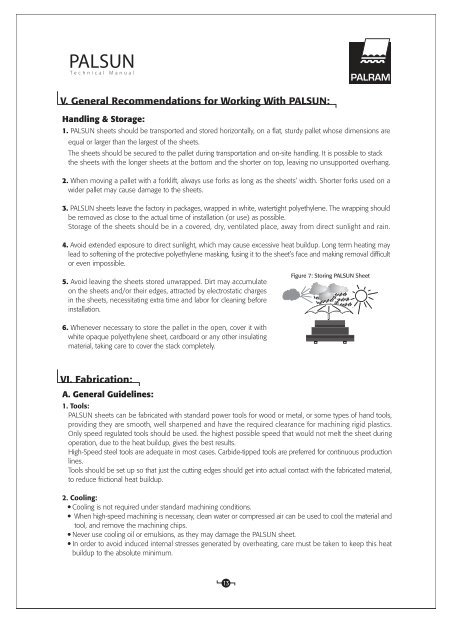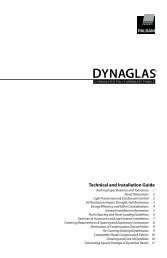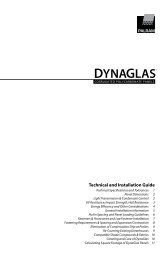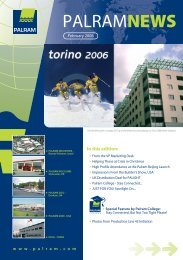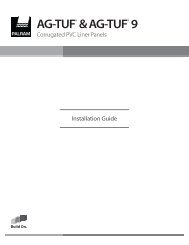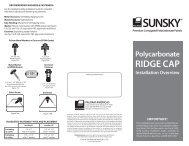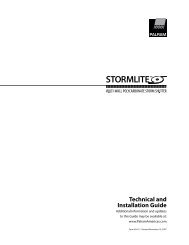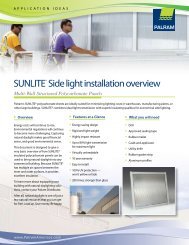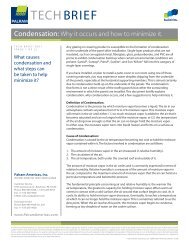PALSUN Technical Guide
PALSUN Technical Guide
PALSUN Technical Guide
You also want an ePaper? Increase the reach of your titles
YUMPU automatically turns print PDFs into web optimized ePapers that Google loves.
<strong>PALSUN</strong><strong>Technical</strong> ManualV. General Recommendations for Working With <strong>PALSUN</strong>:Handling & Storage:1. <strong>PALSUN</strong> sheets should be transported and stored horizontally, on a flat, sturdy pallet whose dimensions areequal or larger than the largest of the sheets.The sheets should be secured to the pallet during transportation and on-site handling. It is possible to stackthe sheets with the longer sheets at the bottom and the shorter on top, leaving no unsupported overhang.2. When moving a pallet with a forklift, always use forks as long as the sheets’ width. Shorter forks used on awider pallet may cause damage to the sheets.3. <strong>PALSUN</strong> sheets leave the factory in packages, wrapped in white, watertight polyethylene. The wrapping shouldbe removed as close to the actual time of installation (or use) as possible.Storage of the sheets should be in a covered, dry, ventilated place, away from direct sunlight and rain.4. Avoid extended exposure to direct sunlight, which may cause excessive heat buildup. Long term heating maylead to softening of the protective polyethylene masking, fusing it to the sheet’s face and making removal difficultor even impossible.5. Avoid leaving the sheets stored unwrapped. Dirt may accumulateon the sheets and/or their edges, attracted by electrostatic chargesin the sheets, necessitating extra time and labor for cleaning beforeinstallation.Figure 7: Storing <strong>PALSUN</strong> Sheet6. Whenever necessary to store the pallet in the open, cover it withwhite opaque polyethylene sheet, cardboard or any other insulatingmaterial, taking care to cover the stack completely.VI. Fabrication:A. General <strong>Guide</strong>lines:1. Tools:<strong>PALSUN</strong> sheets can be fabricated with standard power tools for wood or metal, or some types of hand tools,providing they are smooth, well sharpened and have the required clearance for machining rigid plastics.Only speed regulated tools should be used. the highest possible speed that would not melt the sheet duringoperation, due to the heat buildup, gives the best results.High-Speed steel tools are adequate in most cases. Carbide-tipped tools are preferred for continuous productionlines.Tools should be set up so that just the cutting edges should get into actual contact with the fabricated material,to reduce frictional heat buildup.2. Cooling:Cooling is not required under standard machining conditions.When high-speed machining is necessary, clean water or compressed air can be used to cool the material andtool, and remove the machining chips.Never use cooling oil or emulsions, as they may damage the <strong>PALSUN</strong> sheet.In order to avoid induced internal stresses generated by overheating, care must be taken to keep this heatbuildup to the absolute minimum.13


